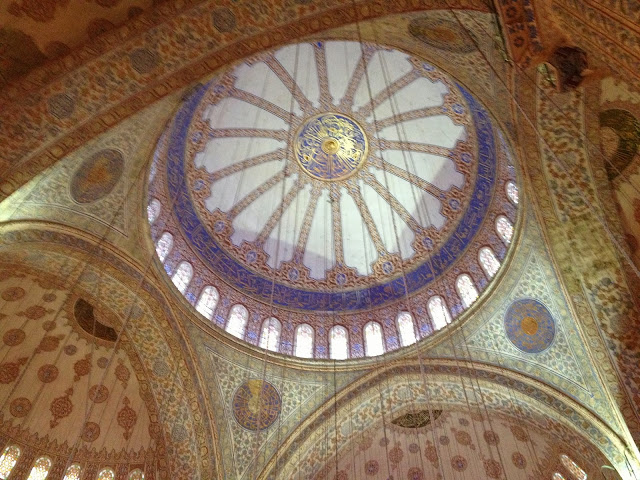......the flight was, well, a twelve-hour flight but the plane was only about half full and we were able to line up three empty seats and lay down and get some sleep on the way over here.
The hotel is very old, but has been beautifully restored. It sits right inside the Old City Wall. This Istanbul peninsula is the most besieged area in recorded history and much of the old wall is intact. Our hotel sits just inside one the main gates.
After arriving at the hotel, the group took a night-time walking tour of the Old City. Virtually everything of historical importance is within ten minutes walking from the hotel. After the tour, we split up and the four of us found a vegetarian restaurant for supper. The food here is great--I've never tasted cheese and olives like what we have here.
The next morning we started what would be a fourteen-hour day of touring. We started with the historic Blue Mosque--a 400-year-old mosque that dominates the Istanbul skyline. It wasn't my first mosque visit but this is probably the most impressive--a lot on the scale of the Mohammad Ali Mosque in Cairo.
As required, Alida and Genevieve bought and wore scarves.
Devin and I wore Dynamo jackets.
The bazaar was mildly-interesting--I've seen them all over the world. I thought the one in Cairo was much more exotic and interesting. This one was very commercialized rather than vendor-oriented.
Returning to the hotel, we had a welcome reception and outline for the second day's touring.
The hotel is very old, but has been beautifully restored. It sits right inside the Old City Wall. This Istanbul peninsula is the most besieged area in recorded history and much of the old wall is intact. Our hotel sits just inside one the main gates.
After arriving at the hotel, the group took a night-time walking tour of the Old City. Virtually everything of historical importance is within ten minutes walking from the hotel. After the tour, we split up and the four of us found a vegetarian restaurant for supper. The food here is great--I've never tasted cheese and olives like what we have here.
The next morning we started what would be a fourteen-hour day of touring. We started with the historic Blue Mosque--a 400-year-old mosque that dominates the Istanbul skyline. It wasn't my first mosque visit but this is probably the most impressive--a lot on the scale of the Mohammad Ali Mosque in Cairo.
As required, Alida and Genevieve bought and wore scarves.
Devin and I wore Dynamo jackets.
After the mosque visit, we headed literally across the street to the Hagia Sophia. Construction started in the year 537 and it was an Eastern Orthodox cathedral for the Patriarchate of Constantinople except for a century of serving as a Roman Catholic center during the Latin Empire. After the Muslim conquest, it was converted into a "victory mosque" from 1453 until 1931. When Turkey became a secular republic at that time, it was converted into a museum. it is/was the fourth largest church in the world. Nearly four times older than the Blue Mosque and much, much larger, it is one of the most impressive buildings I've seen anywhere.
Although the Muslims painted over much of the 5th and 6th century Christian icons, many still remain, including some of Christ and Mary that were never covered over.
This isn't unusual, as Christ is considered an Islamic prophet, just not immaculately conceived nor resurrected. What was kind of kind of surprising is that the tomb and marker of the commander of the Fourth Crusade is located inside the building.
After the Hagia Sophia, we visited the underground Basilica Cistern--constructed in the 6th century. Although dark and low-light, it is considered the greatest example of Byzantine architecture. Also massive, it was necessitated by the fact that Constantinople was the most besieged city in history and had no fresh-water sources during those sieges. Typical of Roman engineering, aqueducts carried water over ten miles into the cistern and rainwater was funneled into the underground lake.
A walkway went out into the center and two of the columns had, at the base, an inverted carving of Medusa.
From there, we went to the grand bazaar--dated 1451 A.D. on the entrance.
Returning to the hotel, we had a welcome reception and outline for the second day's touring.
















No comments:
Post a Comment